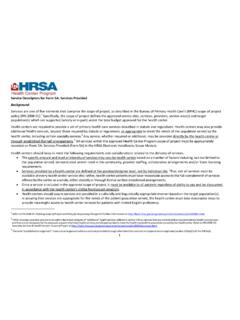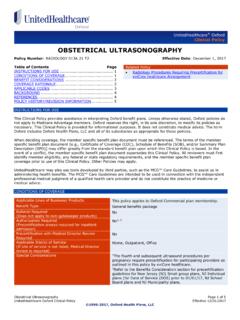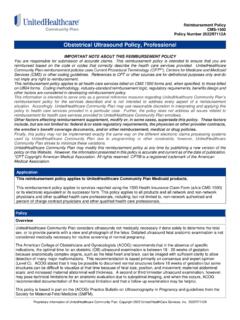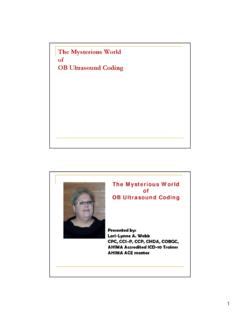Transcription of BASIC CHARACTERISTICS OF THE ULTRASOUND EQUIPMENT
1 BASIC CHARACTERISTICS OF THE 2. ULTRASOUND EQUIPMENT . INTRODUCTION. Performing and successfully completing an ULTRASOUND examination requires multitude of skills that include the medical knowledge, the technical dexterity, and the know-how to navigate the various knobs of the ULTRASOUND EQUIPMENT . Today's ULTRASOUND machines are complex and quite advanced in electronics and in post-processing capabilities. Being able to optimize the ULTRASOUND image is much dependent on the understanding of the BASIC functionality of the ULTRASOUND EQUIPMENT .
2 This chapter will focus on the review of various components of the ULTRASOUND EQUIPMENT and the BASIC elements of image optimization. The following chapter (chapter 3) will introduce some helpful scanning techniques. THE ULTRASOUND EQUIPMENT . ULTRASOUND technology has changed drastically over the past decade allowing for significant miniaturization in the design and manufacturing of ULTRASOUND EQUIPMENT . The spectrum of ULTRASOUND EQUIPMENT today includes machines that can fit in the palm of one's hand and high- end machines that can perform very sophisticated ULTRASOUND studies.
3 It is important to note that before you acquire ULTRASOUND EQUIPMENT , you should have an understanding of who will be using the EQUIPMENT , for which medical purpose it is intended to be used, in which environment it will be used and how will it be serviced. The answer to these important questions will help in guiding you to the appropriate type of ULTRASOUND EQUIPMENT for the right setting. For instance, ULTRASOUND EQUIPMENT destined for low-resource (outreach) settings should have special CHARACTERISTICS such as portability, sturdiness and a back-up battery in order to adjust to fluctuation in electricity.
4 Furthermore, ULTRASOUND EQUIPMENT designed for the low-resource (outreach) setting should be easily shipped for repairs and service. ULTRASOUND Transducers ULTRASOUND transducers are made of a transducer head, a connecting wire or cable and a connector, or a device that connects the transducer to the ULTRASOUND machine. The transducer head has a footprint region (Figure ) where the sound waves leave and return to the transducer. It is this footprint region of the transducer that needs to remain in contact with the body in order to transmit and receive ULTRASOUND waves.
5 A gel is applied to the skin/mucosa surface of the body to facilitate transmission of ULTRASOUND waves given that sound waves do not transmit well in air. Each transducer also has a transducer (probe) marker located next to the head of the transducer in order to help identify its orientation (Figure ). This probe marker Chapter 2: BASIC CHARACTERISTICS of the ULTRASOUND EQUIPMENT 30. can be a notch, a dot or a light on the probe's head. The use of this probe marker in handling the transducer and its orientation will be further discussed in the following chapter (Chapter 3).
6 Figure : Footprint of a curvilinear abdominal Figure : Probe marker of a curvilinear transducer. The footprint region is where the abdominal transducer. The probe marker is sound waves leave and return to the transducer. essential in the proper handling and orientation of the transducer (discussed in chapter 3). Transducers are produced in an array of shapes, sizes and frequencies and are adapted for specific clinical applications. In general, transducers for cardiac applications have small footprints. Vascular transducers have high frequencies and are linear in shape and obstetric and abdominal transducers are curvilinear in footprint shape in order to conform to the shape of the abdomen (Figure ).
7 Figure : Abdominal transducer used for obstetric applications. Note the curvilinear shape of the footprint, which helps to conform to the abdominal curvature. Chapter 2: BASIC CHARACTERISTICS of the ULTRASOUND EQUIPMENT 31. Linear transducers produce sound waves that are parallel to each others with a corresponding rectangular image on the screen. The width of the image and number of scan lines is uniform throughout all tissue levels (Figure ). This has the advantage of good near field resolution. Linear transducers are not well suited for curved parts of the body as air gaps are created between the skin and transducer (Figure ).
8 Figure : Linear transducer used for obstetric scanning in the late second trimester of pregnancy. Note the gap produced between the transducer footprint and the abdominal wall (white arrows). This can be eliminated by simply applying gentle pressure on the abdomen. Figure : Transverse plane of the fetal chest in the second trimester of pregnancy using a linear transducer. Note the rectangular screen image and a good near-field resolution. Sector transducers produce a fan like image that is narrow near the transducer and increase in width with deeper penetration.
9 Sector transducers are useful when scanning in small anatomic sites, such as between the ribs as it fits in the intercostal space, or in the fontanel of the newborn (Figure ). Disadvantages of the sector transducer include its poor near field resolution and somewhat difficult manipulation. Chapter 2: BASIC CHARACTERISTICS of the ULTRASOUND EQUIPMENT 32. Figure : Sector transducer; note the small footprint, which allows for imaging in narrow anatomic locations such as the intercostal spaces or the neonatal fontanels.
10 Curvilinear transducers are perfectly adapted for the abdominal scanning due to the curvature of the abdominal wall (Figure ). The frequency of the curvilinear transducers ranges between 2. and 7 MHz. The density of the scan lines decreases with increasing distance from the transducer and the image produced on the screen is a curvilinear image, which allows for a wide field of view (Figure ). Figure : ULTRASOUND image of the fetal head using a curvilinear transducer. Note that the image is curvilinear in shape (arrows) and has a wide field of view.









